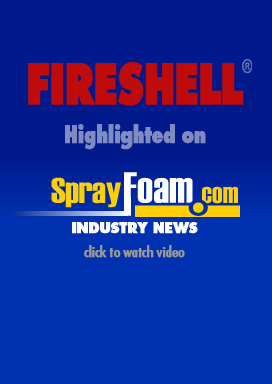Frequently Asked Questions
FIRESHELL® coatings are proprietary non-flammable barrier coatings, which can be sprayed, rolled or brushed on. The manufacturer's warranty only covers product applied by certified applicators. Non-certified applications are allowed, but the warranty is not applicable. All surfaces must be clean for best results. HEATSHEDDER® sealer / primer works excellent as a primer and can be applied directly to most clean substrates, or as a topcoat in dry, interior environments.
The products are manufactured in white or light gray (depending on the product), most are also available in dark gray, red, charcoal, black, salmon. FIRESHELL® coatings are not available in a clear application at this time.
Exterior use of FIRESHELL® coatings can be achieved by applying TPR2 sealer. TPR2 also offers a exterior AFES coatings, a waterbased epoxy and an Aliphatic urethane topcoat. See the coatings section for details.
Building codes for new construction may require a sprinkler system, so check with your local building and fire inspectors. TPR2 recommends the use of as a passive enhancement in conjunction with sprinklers, smoke detectors and fire escapes. In buildings, old or new, higher fire ratings can be achieved, while providing a totally passive, fire resistant barrier and a new level of fire and life safety. TPR2 can provide technical assistance to demonstrate FIRESHELL®ability to provide totally passive fire-retardant barriers.
That depends on the substrate and the level of protection desired. For example, 18 mils (dry)with 10 mils of TPR2 sealer on 1/2" type X gypsum wallboard assembly provides a 1.5-hour rating, unsurpassed in the industry.
Most other coatings are fire retardant, their resins still can burn with enough heat. FIRESHELL® coatings are completely non-flammable. Most other coatings are measured only for their own flame spread or smoke contribution, FIRESHELL® products are fire barrier coats that maintain a HARDSHELL™ protective barrier and contributes ZERO SMOKE. They also provide insulation and oxygen starvation to the substrate. FIRESHELL® coatings are proprietary formulations. There, quite simply, is nothing else like them. Most other coatings generate some fire spread and significant smoke. FIRESHELL® has achieved unsurpassed fire spread and smoke ratings..ZERO fire spread and ZERO smoke developed. FIRESHELL® coatings are unmatched in their fire endurance performance. For example, 50 mils (dry) on a 1/2" type X gypsum wallboard assembly provides a 1 1/2-hour rating, unmatched in the industry. FIRESHELL® barrier coatings are also non toxic, drain safe, water soluble, non fuming, and environmentally safe.
FIRESHELL® can meet code requirements in all 50 U.S. states and in many countries around the world. Your local fire inspector might already be familiar with this product. If not, TPR2 will be happy to provide technical assistance at the local level.
Topcoating FIRESHELL® coatings can be achieved by applying HEATSHEDDER® sealer (part # HS-1) before interior topcoats. TPR2 also offers a class A paint, FIRESAFE® (part# IP-10), a waterbased epoxy and Aliphatic urethane topcoats (part# HS-1) for exterior applications. See the coatings section for details.
Intumescent paints have been on the market for more than 40 years. Some claim to be fire-retardant and cost less than FIRESHELL®. No other intumescent paint on the market is as fire resistant or can match FIRESHELL® for performance and tests passed!
Being a ZERO VOC product, FIRESHELL® has the lowest levels of VOC's of any paint product, standard or intumescent, on the market. The product is completely nontoxic before during and after exposure to flame.
The terms "fire-inert(non-flammable)", "fire-retardant" and "fire-resistant" are often confused.
Fire-inert: A fire-inert material is non burning; that is, it won't support combustion.
Fire-retardant: A fire-retardant material slows burning across a surface of a given a combustible substrate.
Fireproof: a passive fire protection measure, refers to the act of making materials or structures more resistant to fire, or to those materials themselves, or the act of applying such materials. Applying a certification listed fireproofing system to certain structures allows these to have a fire-resistance rating. Fireproofing does not allow treated items to be entirely unaffected by any fire, as conventional materials are not immune to the effects of fire at a sufficient intensity and/or duration.
Fire resistant: A fire-resistive material delays heat penetration through a substrate. The critical difference is based on the method by which the material is tested and rated. Most paints are tested in accordance with ASTM E84. It should be noted that there is no relationship between fire-endurance (ASTM E119) and flame spread (ASTM E84) ratings. Fire endurance ratings apply more specifically to property protection by indicating a period of time before failure. Flame spread ratings indicate a degree of danger to life by measuring how flame will spread over a given surface. Significant consideration should also be given to the degree of smoke development and toxicity when comparing products, since smoke inhalation and smoke damage is most prevalent in fire related accidents.


